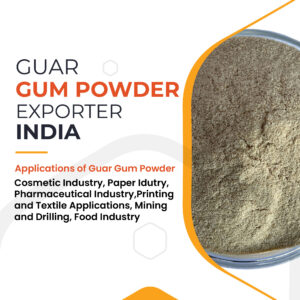Guar gum, or guaran, is the endosperm polysaccharide extracted from the seeds of the guar plant, scientifically known as Cyamopsis tetragonolobus. Belonging to the leguminosae family, this plant naturally thrives in India and Pakistan, with its production now spanning the globe, including the United States. Guaran, characterized as galactomannan, is a relatively large polymer with a high molecular weight. It swiftly hydrates in cold water, resulting in a highly viscous and thixotropic solution. These distinctive properties render the gum derived from this plant widely applicable across various industries.
Similarly, the Cassia Tora plant holds significance, featuring seeds with properties akin to guar. Currently, it is harnessed to produce cassia powder, serving diverse purposes similar to guar powder. This revised rendition incorporates diverse sentence structures, injecting complexity and variety for enhanced readability.
Guar Korma and Cassia Powder as Popular Feed
This is the product that remains after the gum extraction is complete. This product is then used as a concentrated protein source in animal diets. The guar meal is the combined germ fraction and hull fraction that are left after the gum powder has been processed from the seed. Research has shown that the seed contains between 35 and 50% crude proteins. The mixture of germs and hulls after the guar gum has been extracted is at a ratio of 25% germs to 75% hulls. The meal has been found to be protein-rich.
Nutrient Composition
The richness of Cassia Tora Meal is evident, with the regular meal reaching approximately 40%–45% dry matter (DM), while the guar korma meal boasts a higher level at 50%–55% DM. Notably, it contains lysine and sulfur amino acids, with content levels comparable to those found in groundnut meals but slightly lower than those found in soybean meals. This variability is contingent on the extraction level and the relative concentration of the recombined germ and hulls.
Palatability
The elevated gum content in the feed holds the potential to heighten the viscosity of the meal in the intestines, thereby slowing down the digestion rate. This underscores the necessity for careful feed management. Raw guar meal can constitute up to 25% of cattle rations, while the processed meal stands as a viable option as the sole protein component in the cattle diet.
Guar Korma in Poultry Diet
Incorporating guar gum powder by-products into the poultry diet emerges as a practical feeding strategy with the goal of trimming feed costs while upholding essential production levels. This approach proves effective, provided that the utilization rates remain within the range of 5% to 10%.
Fish
In the production of fish such as carp species, research has shown that the meal can replace up to 50% of the fish meal proteins and is therefore a valuable feed ingredient.


This Post Has 0 Comments